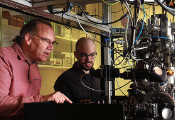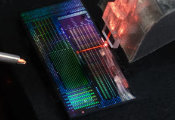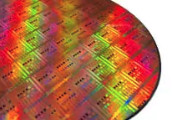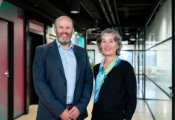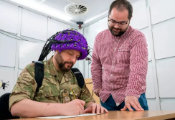No Cavity, No Party: Free-Space Atoms Give Superradiant Transition a Pass
December 17, 2024 -- Isolated atoms in free space radiate energy at their own individual pace. However, atoms in an optical cavity interact with the photons bouncing back and forth from the cavity mirrors, and by doing so, they coordinate their photon emission and radiate collectively, all in sync. This enhanced light emission before all the atoms reach the ground state is known as superradiance. Interestingly, if an external laser is used to excite the atoms inside the cavity moderately, the absorption of light by the atoms and the collective emission can balance each other, letting the atoms relax to a steady state with finite excitations.
However, above a certain laser energy level, the nature of the steady state drastically changes since atoms inside the cavity cannot collectively emit light fast enough to balance the incoming light. As a result, the atoms keep emitting and absorbing photons without reaching a stable, steady state. While this change in steady-state behaviors was theoretically predicted decades ago, it hasn’t yet been observed experimentally.
Recent research at the Laboratoire Charles Fabry and the Institut d’Optique in Paris studied a collection of atoms in free space forming an elongated, pencil-shaped cloud and reported the potential observation of this desired phase transition. Yet, the results of this study puzzled other experimentalists since atoms in free space don’t easily synchronize.
To better understand these findings, JILA and NIST Fellow Ana Maria Rey and her theory team collaborated with an international team of experimentalists. The theorists found that atoms in free space can only partially synchronize their emission, suggesting that the free-space experiment did not observe the superradiant phase transition. These results are published in PRX Quantum.
“While our current simulations were able to reproduce the experimental data, and explained why full synchronization cannot take place under current experimental conditions, a remaining open question is whether the phase transition could happen under different conditions, and at higher densities, where our theoretical methods fail and instead a genuine quantum description is required,” explains Rey.
From Experiment to Theory
In physics, solving complex problems often requires the combined efforts of both theorists and experimentalists. Theorists develop mathematical models and simulations to predict how systems should behave. Conversely, experimentalists conduct experiments to test and challenge these predictions. This collaboration helps bridge the gap between abstract ideas and observable phenomena.
“One of the big questions people are trying to answer is if it's possible to create entangled states in different atomic systems,” explains Sanaa Agarwal, a graduate student in Rey’s group and the paper’s first author. “In a cavity system, this is enabled by these collective all-to-all interactions [atoms interacting one-to-one], but in free space, that still needs to be clarified.”
A cavity system can be fine-tuned to drive atoms into specific quantum states. In contrast, free-space systems are less controlled.
“In free space, there are many effects to look at, like interaction-induced frequency,” says Agarwal. “You also have emission into all possible directions, not just predominantly into the cavity system. So, these effects are expected to change the physics in the system, and that's why we started looking into it, and indeed, we found it’s quite different.”
Simulating the Free-Space System
The specific free-space experimental conditions raised the question of whether the observed behaviors were truly superradiant or coincidental.
To answer these questions, the researchers carried out a series of theoretical simulations using a model that accounted for each atom as a dipole, absorbing and emitting photons from the laser and the light emitted by the other atoms.
“This was an interesting challenge, as the number of accessible states increases linearly in the cavity, but in free space, it can increase exponentially with system size,” Rey elaborates. “In many cases, the interactions can be weak enough that simplified treatments are possible, but it was initially not clear if that was going to be the case in this experiment.”
Argawal adds, “We considered a microscopic model, in which every atom acts like a dipole, and used it to study the emergent properties of the entire atomic cloud. The laser beam is a plane wave, imprinting a specific phase pattern on the atoms, which is crucial in determining how the atoms interact.”
The researchers simulated different conditions, including varying laser power and atom density, to see how these factors influenced the system's behavior.
“Our simulations showed that a “mean-field approximation”, which reduces the complexity greatly by treating the atoms as classical magnets, was enough to reproduce the physics,” Rey notes.
This model was validated with more complex approaches to ensure consistent results.
When Theory Agrees with Experiment
“When we were comparing the theory with the data, we were unsure if it would agree,” Agarwal says. “Some of the data was fairly easy to compare because there was less ambiguity in the experimental apparatus. So when our findings agreed with those results, it gave us a vote of confidence that what we're doing makes sense.”
From their simulations, the researchers concluded that while the free-space experiment agreed with the cavity model, within a narrow range of laser intensities and atom densities, the two systems generally behaved very differently. As the laser power increased beyond a certain threshold, the collective effects that gave rise to superradiance in the cavity disappeared into free space, and the atoms acted more like independent emitters rather than a coordinated group.
Further Enhancing Fundamental Physics
These findings open new research avenues in quantum physics and validate the great value of experiment-theory collaborations to gain a better understanding of the underlying physics.
“While our simulations were able to reproduce the experimental observations in the regime where the system is dilute, and the mean-field approximation is valid, it will be very exciting to study new regimes where our current theory models become obsolete and better treatments are required,” Rey adds. “Our group will be looking for ways to improve our calculations and to prepare us for the new exciting measurements coming ahead.”
This work was supported by the JILA Physics Frontier Center (PFC), the U.S. Department of Energy’s Office of Science, the National Quantum Information Science Research Centers’ Quantum Systems Accelerator, and the National Institute of Standards and Technology (NIST).


